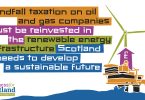The UK Government’s recent betrayal of the renewable energy sector and, for that matter, Scottish voters is disgraceful. The Conservatives are cutting vital renewable energy subsidies for onshore wind farms. Ending the renewable Obligation Certificate subsidy a year early leaves dozens of job creating multimillion pound developments in onshore renewables hanging in the balance. Some companies have already invested millions in projects that would have created jobs, helped to secure Scotland’s energy future and hit carbon reduction targets.
According to Scottish Renewables, around 850 Scottish onshore wind turbines spread across 37 projects (representing 2,129 megawatts of generation capacity) already have planning permission and are now under threat. During last years referendum campaign Ed Davey, then UK Energy Secretary, stated that “Scotland would lose billions of pounds in subsidies for renewable energy projects if it voted for independence, putting its green energy revolution at risk”. The Tories have a majority in England and their manifesto included cuts to renewable subsidies but the SNP have a mandate from Scottish voters for future investment and a target to generate 100% of our energy needs via renewables by 2020. Due partly to Scotland’s higher support for environmentalism but largely due to geography and wind patterns some 70% of UK onshore wind projects and the 10,000 jobs now threatened are located in Scotland.
Devolving the decision on environmental subsidies to each nation would be ideal but, at the very least, all projects currently in the planning stages (some with millions already invested) should still qualify for support even if they start after the new proposed cut-off date. This will also avoid legal action from current investors.
The argument goes that onshore wind is highly subsidised but the alternative, investing in nuclear power, is far more expensive. The cost of nuclear power has not fallen in 50 years and it is actually more expensive than renewables, even more so once you add in the cost of decommissioning and hundreds of years of waste storage. Green energy costs have been coming down substantially, with wind power reducing by 20% since 2008 and solar power costs reducing by up to 80% over the same period. Solar power is now becoming so widespread in hotter countries that Spain is taxing rather than subsidising households with battery storage units at the behest of the big power companies and in Australia domestic solar power generation and storage is now cheaper than buying from retail companies. The UK solar Industry has a plan for solar energy production to be subsidy free by 2020. Offshore the costs are tumbling, Denmark’s wind power field off the east coast of Jutland will generate electricity at roughly half the cost of the Hinckley Point C Nuclear reactor planned by the UK Government.
So expensive is nuclear power that the UK Government is set to subsidise that one power station to the tune of €108 billion and that still doesn’t take into account decommissioning costs met by future generations. The Hinckley C subsidies are so ridiculously large that a consortium of energy providers in Germany and Austria have lodged a complaint with the European Court of Justice over the subsidies, claiming “excessive nuclear power subsidies” amount to an “unlawful operating aid”.
The plant will be built and operated by French state-owned power giant EDF who demanded a guaranteed return on invetsment so the UK Government has guaranteed £92.50 per megawatt hour (200% of the current electricity price) over the 35-year life of the station. The subsidy will be added to household bills that currently contain a levy, (the Renewables Obligation levy), that pays for the renewables subsidies that are being cut to make way for the cost of nuclear. So its not about cost savings but a policy switch to nuclear. Westminster is spinning its true intentions though; Amber Rudd, Secretary of State for Energy and Climate Change, in a press release this week stated the Government was to focus on only ‘backing good-value green energy, lowering prices for hard working families’ (how conservative voters view themselves versus others) with a promise to ‘cut emissions as cost-effectively as possible’. As I have pointed out above, she is guaranteeing higher energy prices and committing the UK to a high cost, highly subsidised energy policy that is actually the least cost effective option.
Scotland, more than anywhere else in the EU, has a competitive advantage in the production of renewable energy, wind and wave in particular. Scotland’s North East also has the ability to evolve its expertise from oil and gas to be a global renewables leader. So cuts to grants that disproportionately impact on Scotland will have a long term negative influence on Scotland’s economy.
Despite Scotland’s commitment to renewable energy, as part of the UK we have fallen from 1st place in 2005 to 8th now on the EY Renewable Energy Country Attractiveness Index. There is, however, some good news for Scotland’s offshore renewable energy developments. This week the EU stated that plans for a North Sea Supergrid linking Scottish and European offshore wind-farms was a “top priority” for commissioners. With £230billion of EU investment (requiring Scottish oil sector subsea skills to implement) construction could start within two years (assuming England votes to allow us to stay in the EU) and this should protect offshore developments such as the 140-turbine Beatrice wind farm in the Moray Firth from UK Government cuts.
The North Sea supergrid would mean renewable energy produced in Scotland could be stored in Scandinavian pump storage hydro schemes until needed, create a pan European low cost energy market and link the EU directly to Iceland’s overly abundant and ultra-cheap geothermal energy through a cable that will go through Scotland. We won’t fully benefit from that cheap energy though, as we will be contracted to buy nuclear power from Hinckley C at many times the cost. Schadenfreude for the Germans suing the UK Government over nuclear subsidies.
Business for Scotland – Prosperity for Scotland – Join us now









[…] to cut Scotland budget by stealth and added to its pathetic £125m support for Aberdeen and its cancellation of grants for Scottish renewable energy generation sector in favour of English nuclear deals you could ask if there is a clear agenda to damage […]
I believe large scale wind farm development in Scotland has probably reached the limit of acceptability. It might be renewable but is proving not to be as environmentally friendly as originally promised; indeed the research is now suggesting the opposite.
We now have projects that are little more than subsidy farms and there is one down near the borders which since commissioning has put not a single kW into the grid but has been paid not to generate!
Tourism is one of our major earners and our visitors do not come to admire our wind farms now that a little over 60% of views feature wind turbines we should be asking if we really need more; should we not be paying more attention to hydro and rooftop solar PV (we have plenty of roof area there is no need to fill fields with panels.)
Enough of putting money into the pockets of speculators this ending of subsidies may be the spur to more creative thinking rather than the hammer blow to prosperity that has been suggested.
I am with you all the way in this but I would also highlight the opportunities for community renewables. Currently the DECC is consulting on removing the pre-accreditation step to renewables development which, although negative in effect, could probably be absorbed by commercial concerns but could not be by community groups wishing to maximise their natural resources since there would be no surety over future income streams.
The proposed route for the interconnector to Norway is not to cross at the closest point (Aberdeenshire) but will be stretched to near Newcastle. This to try to ensure that post-Indy England will try to comply with its Kyoto obligations by using Norwegian, not Scottish, renewable energy. And as part of the UK we will have to pay our share of the capital cost of this deliberate plan to attack the Scottish economy.